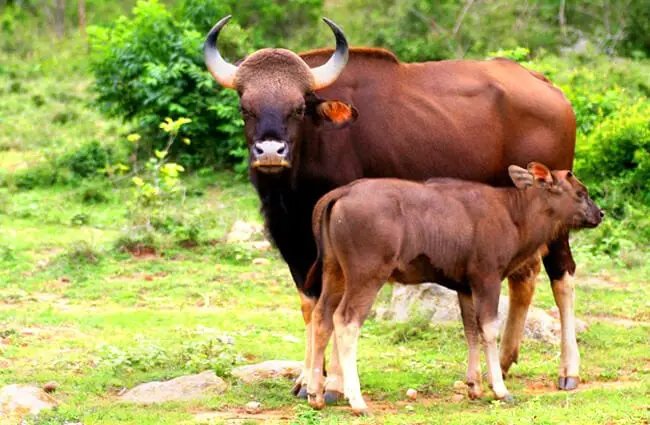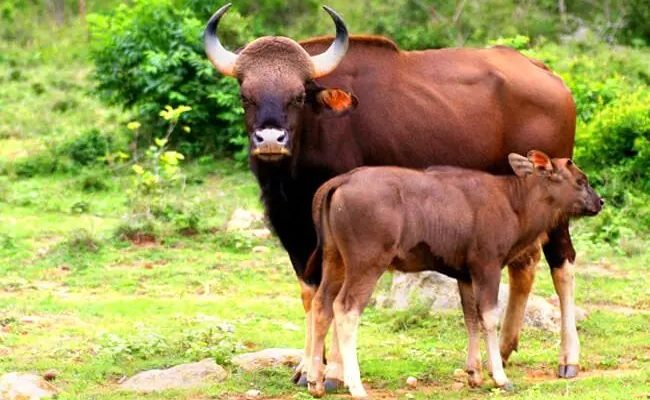
Gaur are not just large; they’re also vital to their ecosystems, serving as both prey and herbivores. Yet, there’s so much more to them than just size and habitat. From their unique social structures to their conservation status, these animals have some fascinating stories to tell. Ready to dive into the world of the gaur? Let’s explore some amazing facts that might surprise you.
The Gaur’s Impressive Size
When you think of the gaur, the first thing that might come to mind is its size. Honestly, they’re one of the largest species of wild cattle. Adult males can weigh anywhere between 1,500 to 2,200 pounds—that’s nearly as heavy as a small car! You might be wondering how such a massive creature manages to survive in the wild.
Their towering stature isn’t just for show. Gaur are built to thrive in their natural habitat, typically found in grasslands, forests, and hilly areas. Their sturdy legs and broad hooves help them navigate rugged terrains as they graze on grasses, leaves, and shoots. Imagine standing next to a gaur and realizing you’d have to look up quite a bit!
Plus, their impressive height—often reaching up to 6.5 feet at the shoulder—gives them a great vantage point to spot predators lurking in the bushes. This combination of size and keen senses makes them less likely to fall prey to threats like tigers or leopards.
Distinctive Appearance
Have you ever seen a gaur? If not, you’re missing out on one of nature’s most striking designs. With a shiny black coat and distinctive white markings on their lower legs, gaurs are hard to forget. Their long, curved horns can grow to be over three feet long, arching dramatically from their heads.
These horns serve multiple purposes. Not only do they deter predators, but they also help in establishing dominance within their social groups. Male gaurs often engage in displays of strength, using their horns to assert authority during mating season. Picture a heavyweight boxing match, but with horns instead of gloves!
Interestingly, their coloration can vary based on age and region. Younger gaurs often have a reddish-brown hue, which gradually darkens as they reach maturity. This change offers them a natural blend with their surroundings, providing camouflage from lurking dangers.
Social Structures of Gaur
While you might think of cows as solitary creatures, gaurs are quite the opposite. They live in herds, typically led by a dominant male. These herds can range from a few individuals to as many as 30 members! It’s fascinating to see how they interact within these groups.
Here’s the thing: within the herd, there’s a clear social structure. Females usually stay in their maternal groups, while males may leave to find their own way as they age. Social bonds are strong among females and young calves, as they rely on each other for protection and guidance.
Mating rituals can be quite intense. When a dominant male is ready to mate, he’ll compete with other males for the attention of females. These contests of strength often involve displays of power and aggression, which is captivating to witness. Think of it like a reality show, where the strongest contestant earns the right to mate!
The Diet of Gaur
Gaur are herbivores, and their diet reflects their size and habitat. They primarily graze on different types of grass, tender leaves, and shoots. Imagine a buffet of greens—that’s what a gaur experiences daily!
Because they’re so large, their digestive system is quite efficient. They have a ruminant stomach, meaning they can extract nutrients from tough plant materials effectively. This is crucial, especially since their habitats are often subject to seasonal changes that affect food availability.
Interestingly, gaurs exhibit selective feeding habits. They often choose younger, fresher plant shoots over older, tougher ones. This means they can play a significant role in shaping their environment, as they help manage vegetation growth through their grazing patterns. Talk about a natural lawnmower!
Gaur’s Role in Ecosystems
Every animal plays a role in its ecosystem, and the gaur is no exception. They’re considered a keystone species, meaning they have a disproportionately large impact on their environment relative to their abundance. By grazing on vegetation, they help maintain the health of grasslands and forests.
Their feeding habits also create spaces for other species to thrive. When guars graze, they trim back dense vegetation, allowing sunlight to reach the forest floor. This encourages new plant growth, benefiting smaller herbivores and insects. It’s like nature’s way of ensuring everyone has a seat at the table!
Additionally, guars are prey for apex predators like tigers. By supporting the food chain, gaurs contribute to the balance of their ecosystems, which is vital for biodiversity. So, the next time you hear about a gaur, remember they’re not just big—they’re crucial for their habitats!
Conservation Status
Despite their resilience, gaur populations are under threat. Habitat loss due to deforestation and agricultural expansion is a significant concern. As their natural habitats shrink, so do their chances of survival.
In addition to habitat loss, poaching poses another danger. Some people hunt gaurs for their meat and hide, which has led to declines in their population numbers in certain areas. Conservationists are working hard to protect these magnificent creatures, often collaborating with local communities to raise awareness about the importance of preserving their habitats.
To support their conservation, several protected areas and national parks have been established in regions where gaurs are most commonly found. These efforts are crucial for maintaining genetic diversity and ensuring these animals can continue to thrive in the wild.
Interesting Behavior of Gaur
Gaur are not just fascinating because of their size or appearance—they have some interesting behavioral traits too. For instance, they are known for their nocturnal tendencies, often being more active during the cooler hours of dawn and dusk. This behavior helps them avoid the heat of the day and evade predators.
You might be surprised to know that gaurs are also quite vocal. They communicate with each other using a variety of sounds, from low grunts to loud bellows. These vocalizations help maintain social structure within the herd and can alert others to potential dangers lurking nearby.
Another intriguing behavior is their tendency to wallow in mud. Not only does this help cool them down, but it also acts as a natural sunscreen, protecting their skin from sunburn and parasites. Imagine taking a refreshing mud bath after a long day—it’s their way of chilling out!
So there you have it—ten fascinating facts about the gaur that highlight just how unique and important these creatures are. From their impressive size and distinctive appearance to their crucial role in ecosystems and ongoing conservation efforts, gaurs are far more than just large animals grazing in a field.
As we learn more about these majestic creatures, it becomes increasingly clear that protecting their habitats and promoting conservation is essential for maintaining biodiversity. After all, when we preserve the gaur, we help preserve the balance of an entire ecosystem. Next time you think about wildlife, remember the gaur and all its amazing contributions to our planet!

